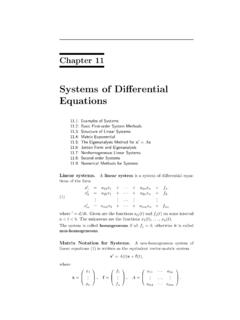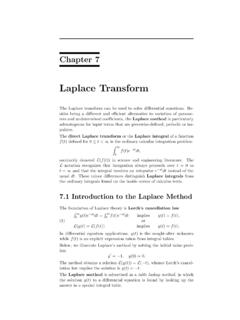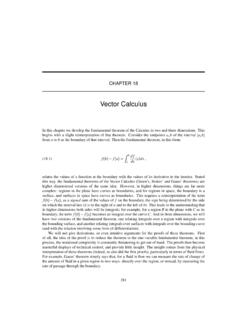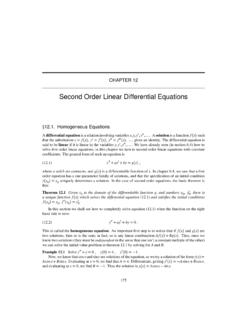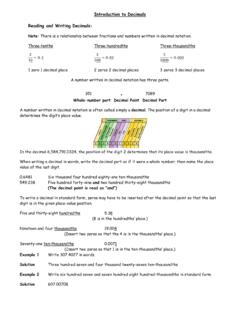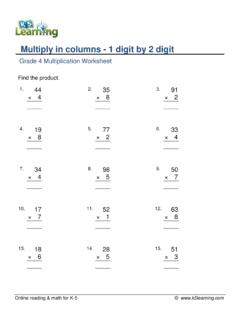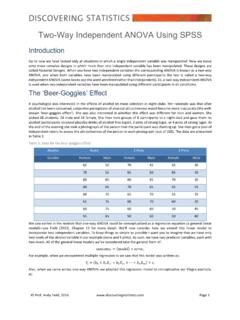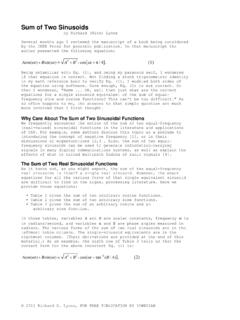Transcription of Polynomials in Two Variables - Math
1 Polynomials in Two VariablesAfunction in two variablesis a functionf:D!RwhereDis a subset ofthe plane, The functiong:R2!Rwhereg(x,y)=xy+3isafunctio nintwovariables. Notice thatg(1,2) = 1 2+3=5, thatg(0, 7) = 0 ( 7) + 3 = 3,and thatg(4,5) = 4 5+3=23. LetDbe the set of all vectors in the plane whosex-coordinates aregreater than or equal to 0. That is,D={(x,y)2R2|x 0}. Thenh:D!Rwhereh(x,y)=px+yis a function in two Variables . Notice thath(4,3) =p4+3=2+3=5,andthath(0, 10) = 10. The functionf:R2!Rwheref(x,y)= x2+2xy+y2 2x+3y+10is a function in two Variables . Check thatf(0,1) = 0+0+1 0+3+10 = 14and thatf(2,3) = 4+12+9 4+9+10=32. g:R2!R2whereg(x,y)=5isaconstantfunction. Theoutputofgis always 5, regardless of the in two Variables have domains that are subsets of the plane, \\\\\\\\\\\\\\\\\\\\\\PolynomialsAdegree 0 polynomial in two variablesis a function of the formp(x,y)=a0,0for some constant numbera0, example,p(x,y)=4isadegree0polynomial,and soisq(x,y)= are just constant functions, and because of that, degree 0 polynomialsare often calledconstant 1 polynomial in two variablesis a function of the formp(x,y)=a1,0x+a0,1y+a0,0wherea1,0,a0, 1,a0,02R,aslongasa1,0anda0,1don t both equal example,p(x,y)=2x+4y+5 is a degree 1 polynomial in two areq(x,y)= 2x+3,f(x,y)=y,andg(x,y)=x y.
2 Degree 1polynomials are often calledlinear 2 polynomial in two variablesis a function of the formp(x,y)=a2,0x2+a1,1xy+a0,2y2+a1,0x+a0 ,1y+a0,0wherea2,0,a1,1,a0,2,a1,0,a0,1,a0 ,02R,aslongasa2,0,a1,1,anda0,2don t allequal example,p(x,y)=2x2+4xy+7y2+3x+2y 8 is a degree 2 polynomialin two Variables . So areq(x,y)=x2 xy,f(x,y)=x2+y2 1, andg(x,y)=xy+x 2 Polynomials are often calledquadratic of polynomialsPolynomials are functions that involve addition and multiplication. Youcan multiply any collection of numbers, and you can add any collection ofnumbers. There are no restrictions. The domain of any polynomial in twovariables is the entire plane, cients and termsIf we have a polynomial such asp(x,y)=a2,0x2+a1,1xy+a0,2y2+a1,0x+a0,1 y+a0,0then we calla2,0x2thex2-termofp(x,y). Similarly, we calla1,1xythexy-term,anda0,1ythey-term, etc. We calla0,0theconstant numbera2,0is called thecoe cientof thex2-term ofp(x,y).
3 Similarly,we calla1,1the coe cient of thexy-term,anda0,1the coe cient of they-term, of the polynomial4x2 3xy+2y2 5x+7is 5x. They2-term is 2y2. The constant term is 7. The coe cient of thex2-term is 4. The coe cient of thexy-term is 3. This polynomial has noy-term, or in other words, they-term is 0 y. The coe cient of they-term is0.**Rows vs. ColumnsWe had previously written the vector inputs and outputs for an additionfunction as row vectors, so that, for example,A(2,4)(3,8) = (5,12).We had previously written the vector inputs and outputs of a matrix ascolumn vectors, so that, for example, ifM= 1301 thenM 02 = 62 . But there really is no di erence between a row vector anda column vector. Writing one versus the other is just a matter of because it s easier to fit row vectors on a line of paper, from now on,we ll also sometimes write row vectors as the inputs and outputs of , instead ofM 02 = 62 we might writeM(0,2) = (6,2).
4 There s reallyno di erence, but rows fit more easily on lines of Polynomials and planar transformationsRecall that we will use the wordsplanar transformationto refer to eitheran addition functionA(a,b):R2!R2or to an invertible matrix functionM:R2! :R2!R2is a planar transformation,and ifp:R2!Ris a degreenpolynomial in two Variables ,thenp T:R2!Ris a degreenpolynomial in two that the above fact is true isn t too di cult, at least for degree 1and degree 2 Polynomials which is most of what we ll apply this fact to. Thatis, it s not so di cult if you ve learned about matrix equations in 3- Variables ,as is often covered in Math 1050 courses. However, it would take us a littlefar from where we want to be to review matrix equations, so instead we lljust look at two illustrations of this fact for now. We ll see more examples inthe LetA(2,1)(x,y)betheadditionfunctionofthe vector(2,1). Thatmeans thatA(2,1)(x,y)=(x+2,y+1).
5 Letp(x,y) be the quadratic polynomialp(x,y)=x2+y2+6. Thenp A(2,1)(x,y)=p(x+2,y+1)=(x+2)2+(y+1)2+6 That s a perfectly good answer, and we can usually stop at this step. How-ever, if you re asked to write your answer in the forma2,0x2+a1,1xy+a0,2y2+a1,0x+a0,1y+a0, 0as you will be in #33 and #35 in the homework exercises, then you ll haveto do a bit more work. You ll have to multiply the expression out and thengroup like terms. That is,p A(2,1)(x,y)=(x+2)2+(y+1)2+6=(x2+4x+4)+(y 2+2y+1)+6=x2+y2+4x+2y+11 Notice thatx2+y2+4x+2y+ 11 is a quadratic polynomial. We com-posed a quadratic polynomial,p, with a planar transformation,A(2,1),andwe obtained a quadratic polynomial,p A(2,1).115 Let s look at the invertible matrixM= 2314 Notice thatM xy = 2x+3yx+4y Written with row vectors, the line above isM(x,y)=(2x+3y,x+4y).Letq(x,y)=y2 x+2. Thenq M(x,y)=p(2x+3y,x+4y)=(x+4y)2 (2x+3y)+2 This is usually a good place to stop.
6 Sometimes, including in #34 and #36 ofthe homework exercises for this chapter, you ll be asked to write your answerin the forma2,0x2+a1,1xy+a0,2y2+a1,0x+a0,1y+a0, 0To do that,q M(x,y)=(x+4y)2 (2x+3y)+2=(x2+8xy+16y2) (2x+3y)+2=x2+8xy+16y2 2x 3y+2We composed a quadratic polynomial,q, with a planar transformation,M,and we obtained a quadratic polynomial,x2+8xy+16y2 2x 3y+ (x,y)=2x2 xy+x 1. Identify the following )p(1,2)2.)p(0, 7)3.)p(3,4)Letq(x,y)=x2+xy y2+2x 3y 2. Identify the following )q(2,0)5.)q( 1,1)6.)q(2,1)Determine whether the Polynomials in #7-18 are constant, linear, or ) 413.)xy8.) 2x2 3xy+4y2+4x 3y+514.) x9.) 3x+4y+115.) 17510.)x2+x y+216.)y2+y+111.) 3xy 217.)5x212.) 2x+y18.)y+3117 For #19-29, give the terms and coe cients asked for of the quadratic poly-nomialp(x,y)=3x2 2xy y+ )x2-term25.) coe cient of thex2-term20.)xy-term26.) coe cient of thexy-term21.)y2-term27.) coe cient of they2-term22.
7 X-term28.) coe cient of thex-term23.)y-term29.) coe cient of they-term24.) constant termIdentify the given row vectors in #30-32 using the matrixM= 1201 30.)M(1,2)31.)M( 3,4)32.)M(2, 3)For the remaining questions, suppose thatp(x,y)=x2+y2,thatq(x,y)=3x2+xy y2+x 2, and thatM= 2130 andN= 131 2 Perform the following compositions of quadratic Polynomials in two vari-ables with planar transformations. What is the resulting quadratic polyno-mial in two Variables ? Write your answers in the forma2,0x2+a1,1xy+a0,2y2+a1,0x+a0,1y+a0, 033.)p A(1,3)(x,y)35.)q A(2, 1)(x,y)34.)p M(x,y)36.)q N(x,y)118
